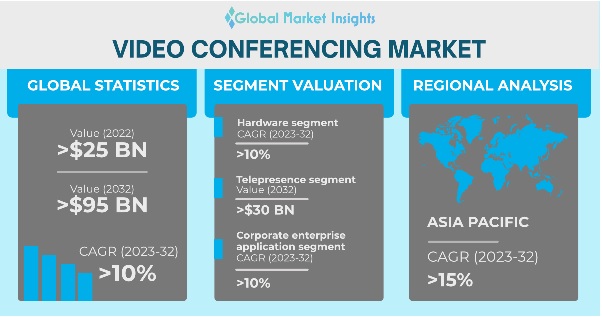
Empowering Global Connections: Meeting the Rising Demand for Video Communication in the Age of Remote Work and Virtual Collaboration
The video conferencing market is growing fast, expected to increase from over $25 billion in 2022 to more than $95 billion by 2032. Key areas like hardware, telepresence, and corporate applications are leading the growth, with the Asia-Pacific region seeing the highest growth rate of over 15%
Distribution and Featured Products
Introduction
Everything You Need to Know About Video Communication
Video communication is a game-changer that lets you connect with colleagues or clients virtually, as if you’re right in the same room. It brings face-to-face interaction to business meetings and internal discussions, breaking down the barriers of distance.
The concept is simple—no fuss or confusion—just seamless visual communication that everyone can easily grasp.
Businesses and individuals alike are embracing video for internal communication because it’s engaging, efficient, and adds a personal touch to everyday interactions.
Key Technology Segments in Video Communication
Main
Learn more
The video communication ecosystem is supported by three essential technological areas:
- Hardware solutions
- Telepresence
- Enterprise applications.
Each plays a vital role in delivering seamless, high-quality video conferencing experiences. Here's a breakdown of each:
Hardware Solutions:
- Includes: Cameras, microphones, and speakerphones designed for high-quality video and audio.
- Purpose: Enhances communication clarity and professionalism in virtual meetings.
- Examples: Logitech cameras, AVer video systems, and JPL headsets.
Telepresence:
- Includes: Advanced video conferencing systems that create immersive, life-like meeting experiences.
- Purpose: Simulates in-person interactions, ideal for high-stakes meetings and conferences.
- Examples: Systems that offer high-definition video and spatial audio.
Enterprise Applications:
- Includes: Software platforms like Zoom for managing video calls and collaboration.
- Purpose: Facilitates scheduling, screen sharing, and team collaboration within businesses.
- Benefits: Supports scalable communication for small meetings to large webinars.


BENEFITS
Benefits of video communicaton

Reduced Travel Time and Costs
The ability for staff to be in client meetings or solve issues without leaving their offices can help drive business productivity.

Optimized Attendance
Increased attendance from dispersed internal teams and clients is possible for participants who otherwise would have been debilitated by location.

Increased Productivity
As a result of improved communications, participants are more in sync, decisions are able to be made faster, and productivity increases.

Structured Meetings
Predefined start and end-times for people calling from different location prior to the video call allows for a more focused discussion.

Employee Retention
Less travel requirements allow a better work/life balance and employees can choose to work from home to alleviate cost of commuting.

Sustained Competitive Advantage
All of these aspects mean video conferencing provides a strong competitive advantage for your business.
Fully dedicated to finding the Best solutions.









